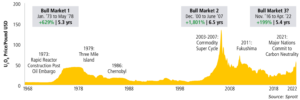SOURCE:
25 refrigerators. That’s how much the additional electricity consumption per household would be if the average US home adopted electric vehicles.
Congressman Thomas Massie—an electrical engineer—revealed this information while discussing with Pete Buttigieg, the Secretary of Transportation, President Biden’s plan to have 50% of cars sold in the US be electric by 2030.
The current and future grid in most places will not be able to support each home running 25 refrigerators—not even close. Just look at California, where the grid is already buckling under the existing load.
Massie claims, correctly, in my view, that the notion of widespread adoption of electric vehicles anytime soon is a dangerous fantasy based on political science, not sound engineering.
Nevertheless, Western governments are falling over themselves to shun hydrocarbons—especially of Russian origin—and promote so-called “green” technologies like electric vehicles and supposed renewables such as wind and solar, which are better termed as unreliables.
Here’s the big problem, though…
Wind and solar power might be useful in specific situations. Still, it’s ridiculous to think they can provide reliable base load power for an advanced industrial economy even as they are now—never mind when every household is running 25 refrigerators.
It’s not complicated.
When it comes to reliable baseload power, most of humanity has only three choices:
1) hydrocarbons—coal, oil, and gas
2) nuclear power
3) abandon modern civilization for a pre-industrial standard of living.
Aside from friendly aliens delivering a new magical energy technology, there are no other alternatives for most places.
So, with Western governments intent on going green, sanctioning Russia, and shunning hydrocarbons, it boils down to a simple choice.
They can either embrace nuclear energy—which has zero carbon emissions—or give up reliable electricity.
I suspect it won’t be long—perhaps sometime this winter—before Western governments turn to nuclear energy in a big way. There are indications they are already doing that.
In short, the green delusion is an enormous market distortion—a blessing in disguise. Distortions in the market allow shrewd speculators to get positioned for big potential profits as they collide with reality.
Uranium mining stocks stand to be a primary beneficiary of this trend. It’s making uranium’s already attractive supply/demand situation even more appealing.
Nuclear power plants account for most of the demand for uranium. They are inseparably linked to the uranium price and market cycles.
A nuclear power plant produces energy by splitting uranium atoms. The energy released boils water, producing steam that drives turbine generators. These plants use fuel made from uranium ore. First, miners extract the ore from the ground. Then it’s enriched and made into fuel pellets.
Every year, the world’s active nuclear plants need around 137 million pounds of uranium. This demand is inflexible, meaning the power plants must obtain uranium or the lights go out.
Couple this inflexible demand with a precarious supply situation, in which most production occurs in unstable regions, like Africa and Central Asia. Further, it typically takes ten years to bring a new mine online.
In short, it is difficult for producers to ramp up production while uranium demand is rising. It often takes years for them to catch up. As a result, price is the only way for the market to resolve itself.
That’s why the uranium price can have extraordinary spikes.
However, the uranium market often doesn’t just settle into equilibrium during these periods. The uranium price often overshoots where it needs to go to balance the market, creating an enormous bull market, which then turns into a massive bear market.
It’s a cycle that has played out three times before, and I think it will occur again soon.
Uranium Cycles
Looking at the Big Picture for uranium, I see a precarious supply situation that includes shrinking production capacity, a long lead time to develop new mines (roughly ten years), dwindling inventories, and an unstable geopolitical situation in which countries are scrambling to secure their energy supplies. Yet, at the same time, there is growing (inflexible) demand from new nuclear power plants.
With supply shrinking and demand rising, I think the stage is set for uranium prices to overshoot to the upside, just as we saw in the previous three bull market cycles with similar dynamics.
